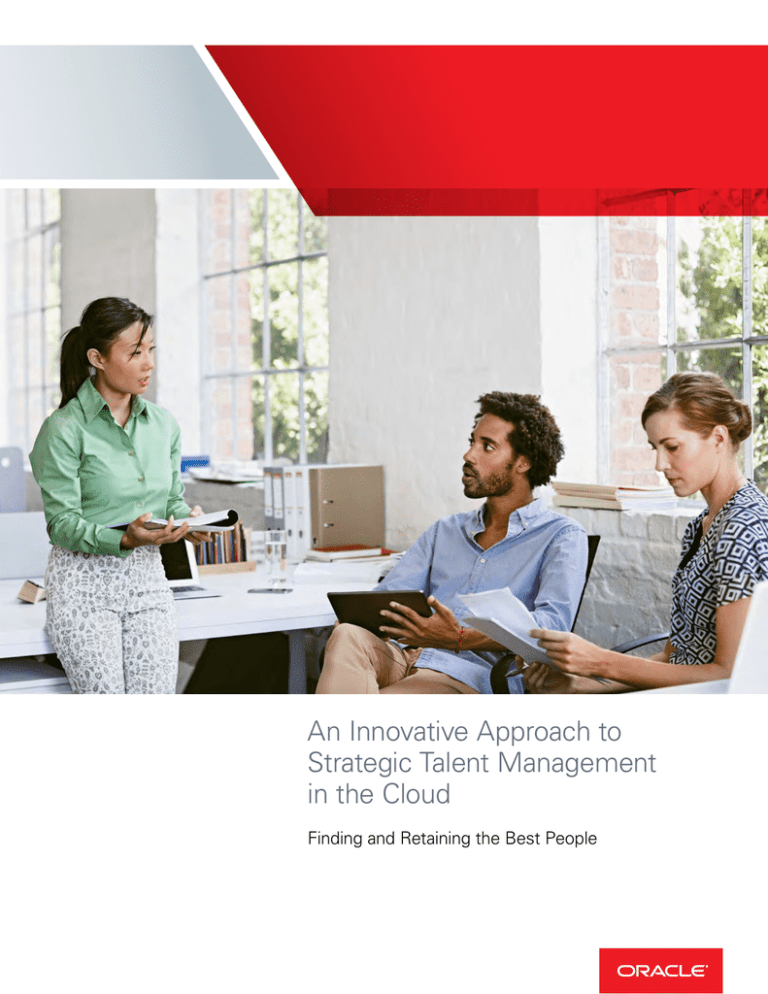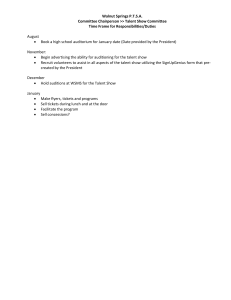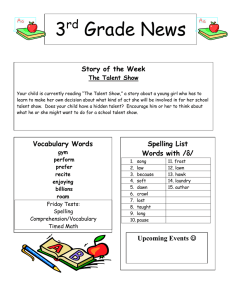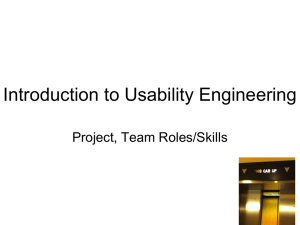
An Innovative Approach to
Strategic Talent Management
in the Cloud
Finding and Retaining the Best People
ManpowerGroup’s ninth annual T
alent Shortage Survey found that
54 percent of employers reporting a talent shortage say it is having
a significant impact on their ability to meet client needs. The most
common impact companies reported is a reduced ability to serve
clients, closely followed by reduced competitiveness and productivity. More than a quarter say that increased staff turnover is a
consequence of talent shortages, with 24 percent citing a negative
impact on employee engagement, innovation, and creativity.
ManpowerGroup, “The Talent Shortage Continues,” 2014
As the world emerges from global recession, it’s clear
that today’s talent management challenges are dramatically different from the ones businesses faced even
a few years ago. PwC’s annual global survey of CEOs
found that a full 63 percent of those surveyed are
concerned about the future availability of key skills.1
It’s no wonder that today’s high-performing businesses
are refocusing on talent management.
Constraints on talent undoubtedly hurt enterprise
growth and profitability. If organizations can’t hire the
right people, they can’t move the business forward.
More than ever before, HR must be closely aligned
with the goals of the business and attract, develop, and
retain employees who can help achieve those goals.
But how can HR tackle the problem and successfully
provide talent solutions for the business?
A CHANGING MARKET
Employers today face a different
labor market than in the past,
and they are finding it difficult
to get and keep high-potential
employees and top performers.
»» Globally, nearly half of the employers surveyed (48 percent)
indicate that hiring activity has
increased compared to the
previous year.
»» For 15 percent, hiring has
jumped significantly and more
than one-third (35 percent)
report that turnover is rising.
»» Nearly two in three respondents are experiencing problems attracting top performers
(65 percent) and high-potential
employees (64 percent)—an
increase from two years ago.
»» More than half report difficulty
retaining high-potential
employees (56 percent) and
top performers (54 percent).
Towers Watson, “2014 Global
Talent Management and
Rewards Study”
1 In
its annual global CEO survey for 2014, PwC recently found that 63 percent of CEOs are concerned
about the availability of key skills. PwC, “17th Annual Global CEO Survey,” 2014.
3
FACT: Global employers are reporting the biggest talent shortages in the skilled trades category.
Engineers are second on the list for the third year in a row. Moving up to third are technicians
in production, operations, maintenance, and other roles. Sales representatives slipped one place
to fourth.
ManpowerGroup, “The Talent Shortage Continues,” 2014
TALENT MANAGEMENT
BEST PRACTICES
Best practices for talent
management in today’s rapidly
changing workplace support a
larger, more strategic role for HR.
»» Start with the business
strategy. Align your HR goals
and strategy with the overall
business strategy.
»» Get the big picture. Find
a comprehensive, integrated
technology solution that
addresses all aspects of talent
management.
»» Know where you are. Assess
your current situation to identify
top contributors and leaders
as well as knowledge gaps
and skills your organization
is missing.
»» “Build” or “buy”? Determine
what talent you can grow
in-house and what talent you
need to acquire from outside
the company.
»» Close the gaps. Implement
your strategy to start filling in
the gaps in your workforce and
enabling the business strategy.
4
How can HR help the business find the talent they
need to compete?
Businesses are facing unprecedented competitive pressures and struggling to keep
up with a constantly evolving market. To succeed, they must address old challenges
with innovation and initiate new ideas for getting ahead. Companies are responding
by launching new initiatives such as acquiring other companies, launching new
products, expanding into new markets, and opening new offices.
Can HR provide a strategic response to help meet business goals?
STEPPING UP
New initiatives to keep the business competitive put pressure on HR because
these initiatives inevitably rely on top talent to get the job done. Traditionally, HR has
been responsible for finding and onboarding talent. Today, however, the role of HR
is expanding to strategic enterprise player as well as the driving force for finding and
retaining key talent.
GOOD NEWS, BAD NEWS
The good news is that most executives acknowledge a problem with their current
talent management systems. In survey after survey, business leaders consistently
identify insufficient talent as a big, red flag in their organization and agree that
programs need to be improved. For HR leaders, this is a perfect storm of opportunity
to own the challenge and provide the solution.
The bad news is that workable talent management solutions have been slow to keep
up with the evolving needs of the business. A comprehensive system that does what
HR, line managers, and employees really need it to do can be costly, expensive to
maintain, and take forever to implement.
Good news again. Things are changing.
FACT: According to a survey by Harvard Business Review Analytic Services, the top-five most
important goals for talent management in 2014 are talent acquisition (64 percent), employee
engagement (59 percent), talent retention (58 percent), goal alignment (55 percent), and training
(53 percent).
Harvard Business Review Analytic Services, “The Age of Modern HR,” June 2014
Start with the larger business strategy and figure
out what talent is needed to achieve those goals.
The approach that successful companies are taking starts with aligning their talent
management solutions with critical business goals. They can then implement the
technology that helps them achieve those goals.
REFLECTING THE GOALS OF THE BUSINESS
Instead of starting with HR goals, start by aligning HR goals with your business strategies.
Businesses win when employees are in sync with companywide goals. HR can help
by making sure that individual and team goals align with the overall business strategy
and that employees can easily collaborate and work together. True alignment of talent
is a key to being competitive.
WHAT WILL HR DO?
HR’s goals should be a reflection of the overall goals for the business with the
primary question being, “What can HR contribute to the business strategy?”
In this new role, HR spearheads the talent management effort: helping line managers
staff new initiatives, assessing current talent, and reviewing talent processes to see
what works—and what doesn’t.
For help in this new role, HR organizations are turning to technology to provide
a talent management system that provides world-class recruiting strategies and
can effectively cover all the stages of the employee lifecycle.
START WITH THE
BUSINESS STRATEGY
Too often HR finds itself starting
with its own goals and objectives
for a “bottom-up” approach.
Starting with the goals of the
business and a “top-down”
approach lets HR ensure that
their goals (and the goals for the
talent management solutions
they seek) are in alignment with
the goals of the business.
Ask these questions to better
align your HR strategy with the
business strategy.
»» What is the business
committed to delivering?
»» How can people help deliver
on that commitment?
»» How many people do you
need to deliver on that
commitment?
»» What kind of people do
you need?
»» Which roles are the most
critical to fill?
5
FACT: 70 percent of job seekers use mobile devices when searching for positions; mobile-friendly
job applications are the future of the recruitment process.
Meghan M. Biro, “5 Ways to Use Mobile to Recruit Top Talent,” Forbes.com (blog), Oct. 27, 2013,
forbes.com/sites/meghanbiro/2013/10/27/5-ways-to-use-mobile-to-recruit-top-talent/?ss=talentstrategies
BUILD YOUR OWN
TALENT POOL
Reduce your dependence on
third-party recruiters and external
resume databases by creating
an internal database of quality
candidates. You need to manage
and maintain it, but significant
results include lower sourcing
costs and a database of presourced, qualified candidates
with whom you already have
a relationship. The next time a
job opens up, this tailored-by-you
talent pool is your first stop.
But where do you find these
quality candidates?
»» Social networking and social
media. Facebook, LinkedIn,
and Twitter are good places
to start, but don’t stop there.2
Investigate special interest
social media being marketed to
specific audiences.
»» Job boards. Find the ones
with the highest likelihood of
attracting qualified talent. Post
to them automatically.
»» Employee referrals. Pure gold.
»» Career Opportunities section
on your website. Don’t forget.
The addition of social media to the mix of talent
management challenges requires a comprehensive,
integrated solution that simplifies—not complicates.
Strategic talent management requires looking at the big picture—not just isolated
pieces. Everything is connected, making every aspect of talent management exponentially more critical and more complex.
A HOLISTIC APPROACH TO TALENT MANAGEMENT
When functional HR silos are brought together and companies can look at talent
management issues from an integrated perspective, then executives and managers
can be more efficient in their responses. For example, they can more easily identify
leaders for key projects and act quickly to lower the risk of losing top performers.
And because the challenges have been integrated, so are your responses. For
example, it doesn’t make sense to have a great recruitment strategy just to lose your
top recruits because you have no employee development programs. You might have
great leaders today, but if they leave at a crucial time with no contingency in place,
it could jeopardize the entire project. Effective talent management strategies cover
the entire employee lifecycle, including
•Sourcing, recruiting, and onboarding
•Performance and goal management
•Talent review and career and succession management
•Learning and development
TURNING TO TECHNOLOGY
Technology—including social collaboration—has helped make talent management
systems more efficient. A solution that’s fully integrated with core HR processes
changes the way HR approaches talent management. And improving the efficiency of
individual talent processes and integrating them into a single platform (and a single
dashboard) simplifies the job of HR.
An integrated talent management system can also provide insight for the rest of the
business—all in alignment with business strategies. By integrating data and processes
so that seemingly unrelated data points can be compared and analyzed, business
leaders gain the insight to make more-informed decisions.
2 According to a Jobvite survey, 83 percent of social job seekers use Facebook, 40 percent use Twitter, 37
percent use Google+, and 36 percent use LinkedIn; see”2014 Jobvite Job Seeker Nation Study,” jobvite.com.
6
“Organizations are still missing the mark: Less than half (49 percent) of organizations report
being effective at providing traditional career advancement opportunities to employees.”
Towers Watson, “2014 Global Talent Management and Rewards Study”
It’s critical to have a goal—but you also need to
know how far you are from reaching it. Once you’ve
aligned talent needs with the business strategy, you
need to take stock of your current situation.
Consider this scenario: A company sees enormous growth potential in their product
and services business. The HR team undertakes an evaluation of current talent and
also looks at the retirement plans of the engineers, along with their tenure. They
also review skill sets for the rest of the workforce. In other words, by reviewing their
talent in an integrated way, they realize that there is an enormous gap: Not only
does the current workforce lack all the right skills, but many of the skills the company
does have are found in employees who will be retiring over the next 10 years.
The company realizes that it cannot currently execute on its business strategy
because it doesn’t have the right talent.
THE TRUTH ABOUT TALENT REVIEWS
The talent review is one of the most strategic processes within an organization and
provides some of the best information about the talent in your business. However,
it is also one of the most dreaded processes—by managers and their teams alike.
Talent reviews are generally manual processes, and preparation is painstakingly laborintensive. Action items from the review are often not tracked, and—after the review
process—there’s little or no follow-up and accountability.
EASIER EVALUATIONS, BETTER INSIGHT
Technology can make talent reviews easier and more useful. It can help ensure that
the best talent is recognized, that all talent is fairly assessed, and that the right talent
is developed for the right jobs. Comprehensive talent management solutions that cut
down on manual processes and make decisions actionable are now available with
•Interactive dashboards that let HR rank talent based on potential and performance
and incorporate both formal data (such as performance reviews) and informal data
(such as peer kudos)
•Visual, interactive reviews that help managers identify top performers and
potential leaders
•Embedded and predictive analytics to identify at-risk top performers so that
managers can intervene before valuable talent is lost
KNOW WHERE YOU ARE
Ask these questions to determine where you are in your
strategic talent management
planning.
»» What’s your current talent
landscape? (Look at the depth
and strength of your bench
for key jobs. Examine skill
gaps, performance gaps,
and leadership capabilities.)
»» Have you identified employees for your succession
pool (those who will be
ready for promotion in one
to three years)?
»» Have you identified employees for your development
pool (those who will be
ready for promotion in three
to five years)?
»» How prepared are these
employees? (What skills do
they need to fulfill future
requirements? Identify the
skills they have and the skills
they need.)
»» What can HR do to help them
prepare? (Can the needed
skills be developed within the
timeframe you have?)
7
“One of our goals at National Instruments is to create a great place to work for
our employees. As an HR team, we want to be able to focus on developing our
talent. Since we have talent located in approximately 50 countries, it is very
important that our HR system is industry-standard and consistent across
borders so that HR, managers, and employees can spend less time gathering
data and more time using that data for effective decision-making.”
Wendy Cottrell, Senior HRIS Manager, National Instruments
FACT: 23 percent of survey respondents with talent shortages are preparing to adopt alternative
work models. One in 10 have increased their focus on their talent pipeline. Other employers are
redesigning existing work procedures, offering flexible or virtual work arrangements or leveraging
contingent workers.
ManpowerGroup, “The Talent Shortage Continues,” 2014
How you fill the talent gaps in your organization
depends on your business goals. A talent evaluation
helps you identify gaps and decide whether you need
to focus on a “build” or “buy” strategy.
Once you understand your talent baseline, you can start closing the gaps between
where you are and where you need to be.
STRATEGIES TO CONSIDER AS YOU CLOSE TALENT GAPS
Consider the following as you develop your strategy for finding the right people to close
the talent gaps in your organization.
•Build a strong talent pool for those situations where you need to buy the right
talent. Employee referrals produce the best-qualified talent; social media and social
networking should also be a part of your sourcing.
•Develop a strong onboarding program. Good onboarding programs have a lasting
impact on retention.
•Focus on performance management. Performance processes that recognize the
relative value of an employee’s contribution drive talent retention.
•Offer innovative reward strategies. Organizations can capitalize on reward strategies
that attract and engage top talent. Both traditional pay-for-performance programs and
corporate business rewards are critical to the retention of top performers.
•Consider the trend toward the “democratization” of compensation. Employees can
give rewards to each other and use social media connections to find the skills they
need to get the job done.
•Align people to the business. Link employee and line manager behavior to results
that matter—not just to the organization but to customers and business partners.
CHOOSE A “BUILD” OR “BUY” STRATEGY
The ideal strategy for HR depends on which skills and talent are most critical for
executing the strategies that achieve the goals of the business. Based on your talent
evaluations, you can decide whether you can groom and grow the skills the business
needs from internal talent, or whether you need to buy an infusion of talent from
outside the organization. The right answer might be a combination of both strategies,
so you may want to assign priorities and timeframes to determine your initial focus.
CHOOSE BUILD...
»» If your focus is on:
- Stability through retention
- Legacy knowledge
- Capitalizing on a strong bench
- Finding the right solution,
no matter how long it takes
»» Overcome talent gaps with:
- Development planning
- Succession management
- Roles designed to fit talent
- Assessments with learning
and development interventions
- Coaching and mentoring
- Performance management
CHOOSE BUY...
»» If your focus is on:
- Speed
- Unique skills or talents
- Overcoming a weak bench
- Seeking new perspectives
»» To overcome your talent gaps:
- Identify the most-critical areas
that need external talent
- Onboard employees faster
IN BOTH CASES...
»» Develop strong onboarding
programs for better retention.
»» Practice good performance
management. Companies that
regularly talk to employees
about progress and outcomes
outperform those that don’t.
9
FACT: More than 1,700 Oracle Human Capital Management (Oracle HCM) applications customers
have contributed to the development of Oracle Talent Management Cloud, participating in a variety of
design, testing, and feedback sessions. This, combined with insight from our internal team of seasoned
HR leaders, has allowed Oracle to deliver a talent management solution that addresses the challenges
faced by today’s HR organizations and supports HR’s shift to a more strategic role.
FINDING AND RETAINING
THE BEST POSSIBLE TALENT
Business executives are
depending on HR to source,
recruit, develop, and retain the
best talent, and HR is finding
solutions in Oracle Talent
Management Cloud.
»» Social networking tools that
increase employee information
sharing and engagement
»» Flexible, holistic goal and
performance management
»» Integrated and embedded
analytics to support informed,
data-driven decision-making
»» Comprehensive learning solutions that map to the needs
of individual employees and
organizational goals
Oracle Talent Management Cloud lets HR manage
everything from recruiting to talent reviews and
development—all in a single, cohesive software-asa-service (SaaS) system.
WHAT’S DIFFERENT ABOUT ORACLE TALENT MANAGEMENT CLOUD?
Oracle has rethought the business of talent management and has designed a system
to support HR’s shift from administrative to strategic. Areas such as performance
management have been redesigned away from the tracking of papers, forms, and
ratings and moved toward strategic growth and development activity with kudos,
feedback, and ongoing goals.
Oracle Talent Management Cloud provides end-to-end talent management in a single
system so that HR can
•Find, grow, and develop key talent with modern talent management
•Align individual goals with corporate goals
•Drive a strategic, end-to-end talent management strategy with a single, integrated
system for all talent-related activities
»» Support for integrating with
existing core HR systems
including Oracle’s PeopleSoft
and Oracle E-Business Suite
•Leverage social media and mobile technology to broaden recruiting reach,
generate high-quality employee referrals, and increase employee engagement
CONTACT US
Only Oracle HCM has the workforce insight for superior talent management, as well
as the breadth and depth to provide the global HR foundation that companies need
to support current business goals. Oracle’s comprehensive, end-to-end system lets
companies apply best practices to processes across the entire employee lifecycle
rather than just to a single, isolated process.
For more information on
how to refocus your team on
managing talent, call
+1.800.ORACLE1
to speak to an Oracle
representative or visit
oracle.com/hcm.
Outside North America, visit
oracle.com/corporate/contact/
global.html to find the phone
number for your local
Oracle office.
10
•Analyze talent information to make better decisions
A COMPLETE, INTEGRATED SOLUTION—ONLY FROM ORACLE
Understanding and influencing talent is critical to the success of an organization.
Reviewing talent, aligning individual goals to business strategies, rewarding top
talent, and providing easy-to-use social tools are key steps. With Oracle Talent
Management Cloud, HR leaders can provide the strategic insight and workforce
planning to attract and retain the best talent and stay ahead of the competition.
“Thanks to Oracle Human Capital Management Cloud, we gained anytime,
anywhere access to integrated employee data, enabling us to create moreeffective performance management and identify top talent to support
future growth. We have gained recruitment analytics, simplified performance management and talent review processes, and reduced IT costs.”
Bavneesh Gulati, Senior Vice President, Human Resources, Kalpataru
11
Oracle Corporation
WORLDWIDE HEADQUARTERS
500 Oracle Parkway
Redwood Shores
CA 94065
USA
WORLDWIDE INQUIRIES
Phone:+1.650.506.7000
+1.800.ORACLE1
Fax: +1.650.506.7200
oracle.com
CONNECT WITH US
100322780 | C19315
Copyright © 2014, Oracle and/or its affiliates.
All rights reserved. This document is provided
for information purposes only, and the contents
hereof are subject to change without notice. This
document is not warranted to be error-free, nor
subject to any other warranties or conditions,
whether expressed orally or implied in law,
including implied warranties and conditions
of merchantability or fitness for a particular
purpose. We specifically disclaim any liability
with respect to this document, and no contractual
obligations are formed either directly or indirectly
by this document. This document may not be
reproduced or transmitted in any form or by any
means, electronic or mechanical, for any purpose,
without our prior written permission.
Oracle and Java are registered trademarks of
Oracle and/or its affiliates. Other names may be
trademarks of their respective owners.
Intel and Intel Xeon are trademarks or registered
trademarks of Intel Corporation. All SPARC
trademarks are used under license and are
trademarks or registered trademarks of SPARC
International, Inc. AMD, Opteron, the AMD
logo, and the AMD Opteron logo are trademarks
or registered trademarks of Advanced Micro
Devices. UNIX is a registered trademark of The
Open Group.







